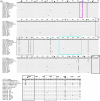Molecular and phylogenetic analysis of bovine coronavirus based on the spike glycoprotein gene
- PMID: 22634277
- PMCID: PMC7106151
- DOI: 10.1016/j.meegid.2012.05.007
Molecular and phylogenetic analysis of bovine coronavirus based on the spike glycoprotein gene
Abstract
Bovine coronavirus has been associated with diarrhoea in newborn calves, winter dysentery in adult cattle and respiratory tract infections in calves and feedlot cattle. In Cuba, the presence of BCoV was first reported in 2006. Since then, sporadic outbreaks have continued to occur. This study was aimed at deepening the knowledge of the evolution, molecular markers of virulence and epidemiology of BCoV in Cuba. A total of 30 samples collected between 2009 and 2011 were used for PCR amplification and direct sequencing of partial or full S gene. Sequence comparison and phylogenetic studies were conducted using partial or complete S gene sequences as phylogenetic markers. All Cuban bovine coronavirus sequences were located in a single cluster supported by 100% bootstrap and 1.00 posterior probability values. The Cuban bovine coronavirus sequences were also clustered with the USA BCoV strains corresponding to the GenBank accession numbers EF424621 and EF424623, suggesting a common origin for these viruses. This phylogenetic cluster was also the only group of sequences in which no recombination events were detected. Of the 45 amino acid changes found in the Cuban strains, four were unique.
Copyright © 2012 Elsevier B.V. All rights reserved.
Figures





References
-
- Alekseev K.P., Vlasova A.N., Jung K., Hasoksuz M., Zhang X., Halpin R., Wang S., Ghedin E., Spiro D., Saif L.J. Bovine-like coronaviruses isolated from four species of captive wild ruminants are homologous to bovine coronaviruses, based on complete genomic sequences. J. Virol. 2008;82:12422–12431. - PMC - PubMed
-
- Baker S.C. Coronaviruses: Molecular Biology. In: Mahy B.W.J., Van Regenmortel M.H.V., editors. Desk Encyclopedia of General Virology. Elsevier; USA: 2008. pp. 445–453.
-
- Barrera M., Rodríguez E., Bentancourt A., Frías M.T., Brandão P.E. First report in Cuba of bovine coronavirus detection in a winter dysentery outbreak. Span. J. Agric. Res. 2006;4:221–224.
Publication types
MeSH terms
Substances
LinkOut - more resources
Full Text Sources

